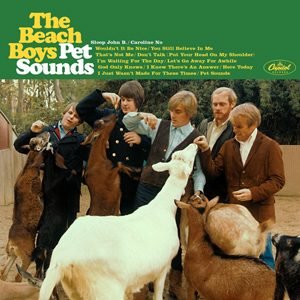Released in 1966, Pet Sounds by The Beach Boys stands as a monumental pivot point in both the band’s discography and the evolution of popular music. Up to that moment, The Beach Boys had been largely defined by their sun-soaked, surf-rock anthems like “Surfin’ USA” and “California Girls.” Their music celebrated the carefree California lifestyle, complete with shimmering harmonies and the unmistakable charm of the American youth culture of the early ’60s. But with Pet Sounds, the band, led by the ambitious vision of Brian Wilson, ventured into uncharted emotional and sonic territory.
In stark contrast to the breezy escapism of their earlier work, Pet Sounds presents a deeper, more introspective sound that reflects Wilson’s personal struggles and yearning for artistic expression. Influenced by The Beatles’ Rubber Soul, Wilson was determined to create an album that transcended the typical pop formula. This was not just another collection of catchy singles but a cohesive, sonically intricate statement. Wilson once described the album as his “pocket symphony,” and his intention was clear: to craft something timeless, something that would challenge both the listener and the conventions of the time.
Artistic Intentions
The broader music landscape was in the midst of rapid evolution in the mid-’60s, with artists experimenting more freely with studio production, instrumentation, and themes. In this climate, Pet Sounds was a departure not only for The Beach Boys but also for the pop genre itself. Where most records of the time were aiming for the top of the charts, Wilson was striving for something more—a work of art that was complex yet accessible, rooted in emotion and innovation. His vision was not just to write songs; he wanted to create an immersive experience that reflected love, loneliness, insecurity, and hope.
Pet Sounds can be seen as a precursor to the concept albums that would follow, with its seamless transitions between tracks, the use of unconventional instruments (from theremins to bicycle bells), and a lyrical focus that delved into the emotional rather than the superficial. It represented a maturation for The Beach Boys, and in doing so, it pushed the boundaries of what pop music could achieve. Wilson wasn’t just adding layers to the band’s sound; he was reinventing it entirely. And while this new direction may have alienated some of the band’s earlier fans, it also redefined their legacy, placing them at the forefront of artistic innovation in music.
Sonic Exploration

The sonic landscape of Pet Sounds is one of its most defining and revolutionary qualities. Brian Wilson, who took full control of the album’s production, approached the studio like a painter with a blank canvas. Every detail was carefully considered, from the intricate vocal harmonies to the unorthodox instrumental arrangements. This meticulousness resulted in an album that feels lush and immersive, drawing listeners into a world that’s simultaneously intimate and expansive.
Production Quality
At a time when many pop records were still relatively simple in their production, Pet Sounds was a stunning example of studio innovation. Wilson, working with renowned session musicians known as The Wrecking Crew, utilized advanced recording techniques like multi-tracking to layer sounds in ways that had never been heard before.
The production is crisp and pristine, with an almost orchestral depth that allows each instrument to shine without overwhelming the others. Tracks like “God Only Knows” and “Wouldn’t It Be Nice” showcase a symphonic clarity, where even the softest notes are audible in the rich tapestry of sound. Wilson also incorporated techniques like reverb and echo to give certain moments a dreamlike, almost ethereal quality, which aligned perfectly with the album’s reflective mood.
What’s remarkable is that Wilson created this sonic masterpiece without the benefit of modern technology. Working within the constraints of the 1960s recording equipment, he managed to produce a record that sounds fresh and timeless even today. The attention to detail in the mixing and mastering processes ensured that Pet Sounds was sonically ahead of its time, lending an emotional weight to each track that might have been lost with a more conventional production approach.
Musical Arrangements
The arrangements on Pet Sounds are among the most innovative in pop music history. Wilson’s vision for the album was rooted in an experimental use of instruments, often combining classical elements with the unconventional. Standard rock instrumentation (guitars, bass, drums) takes a backseat to more unusual choices, such as the theremin in “I Just Wasn’t Made for These Times,” the lush strings in “Don’t Talk (Put Your Head on My Shoulder),” and the use of everyday objects like bicycle bells and Coca-Cola cans to create unexpected textures.
Wilson’s arrangements also put a heavy emphasis on layered vocals, a hallmark of The Beach Boys’ sound. Yet, on Pet Sounds, the harmonies serve not just as catchy refrains but as an integral part of the emotional fabric of the songs. On “God Only Knows,” for instance, the multi-tracked voices cascade like a waterfall of sound, building a sense of both hope and melancholy that complements the song’s lyrical themes. Every harmony, every background vocal, is meticulously placed to add depth and complexity, reinforcing the album’s sense of longing and introspection.
Beyond the sheer variety of instruments, Wilson’s arrangements stand out for their dynamic range. The songs ebb and flow between moments of quiet reflection and sweeping, almost cinematic grandeur. This is particularly evident on tracks like “Let’s Go Away for Awhile,” an instrumental piece that showcases Wilson’s talent for crafting wordless emotion through layered arrangements, blending strings, percussion, and subtle horns to create a peaceful, yet emotionally charged atmosphere.
Genre Elements
Musically, Pet Sounds defies easy categorization. At its core, it is a pop record, but it incorporates elements of classical music, jazz, and even avant-garde soundscapes. The influence of baroque pop is evident in the orchestral arrangements and the use of complex, classical chord progressions. Songs like “God Only Knows” and “You Still Believe in Me” are perfect examples of this, blending pop sensibilities with the lush instrumentation typically found in chamber music.
The album also touches on elements of psychedelia, especially in its use of reverb and unusual sound effects, predating some of the more experimental works of the late 1960s. Tracks like “I Just Wasn’t Made for These Times” showcase this subtle shift, as they experiment with dissonance and otherworldly sounds, pointing toward the psychedelic rock that was soon to explode.
At the same time, Pet Sounds remains firmly rooted in the tradition of vocal harmony-driven rock that The Beach Boys had mastered, making it a bridge between the sunny, simple pop of the early ’60s and the more complex, genre-blending sounds of the decade’s latter half. Wilson’s ability to merge these genres without losing the emotional core of the music is a testament to his genius as both a composer and producer. It’s a sonic exploration that not only pushed boundaries but also laid the groundwork for the concept albums and genre experiments that would come to define the era.
Lyrical Analysis

While Pet Sounds is often lauded for its groundbreaking production and sonic innovation, the album’s lyrical content is equally significant in shaping its emotional depth. Brian Wilson, collaborating primarily with lyricist Tony Asher, crafted words that move beyond the carefree themes of The Beach Boys’ earlier hits. Instead of celebrating youthful rebellion or beachside romance, Pet Sounds delves into more introspective and emotionally complex territory, exploring themes of love, insecurity, doubt, and the search for meaning.
Themes and Messages
At its core, Pet Sounds is an album about the tension between youthful idealism and the inevitable reality of growing up. The lyrics capture the vulnerability of navigating love and relationships while grappling with self-doubt and uncertainty. Songs like “Wouldn’t It Be Nice” express the longing for an idealized, future happiness—one where youthful love has matured into something stable and permanent. Yet, even in this hopeful sentiment, there’s an underlying sense of frustration with the limitations of reality.
Recurring themes of isolation and unfulfilled desires surface throughout the album, most notably in tracks like “I Just Wasn’t Made for These Times” and “Caroline, No.” Both songs convey a deep sense of alienation and disappointment. “I Just Wasn’t Made for These Times” is particularly poignant, with Wilson’s lyrics reflecting his own feelings of not fitting into the social or musical expectations of the era. This emotional isolation becomes a central thread, one that echoes across multiple songs, positioning Wilson as both the artist and the subject—an outsider grappling with inner turmoil, striving for something deeper in a world that often doesn’t understand him.
Additionally, the album touches on themes of nostalgia and loss. The closing track, “Caroline, No,” laments the passing of innocence and the disillusionment that comes with growing older. It’s a heartbreaking reflection on change, framed as a plea for the return of something—or someone—that once seemed perfect and pure but is now irrevocably lost.
Lyrical Depth
The lyrics on Pet Sounds possess a poetic subtlety that is often absent from typical pop music of the time. They are neither overly abstract nor purely narrative, but rather strike a balance between personal introspection and universal emotion. This balance allows listeners to relate to the songs on a deeply personal level while also appreciating the specific, autobiographical threads that run through the album.
Wilson and Asher’s writing is deceptively simple; many of the lyrics use straightforward language, yet convey a complexity of emotion that rewards careful listening. Take “God Only Knows,” for example, where the refrain “God only knows what I’d be without you” encapsulates a profound sense of dependence and vulnerability within the context of love. It’s a line that could easily be interpreted as romantic, but there’s also an undercurrent of uncertainty, a recognition of how fragile such connections can be.
“Don’t Talk (Put Your Head on My Shoulder)” offers another instance of lyrical restraint. Rather than relying on elaborate metaphors or long-winded expressions of emotion, the lyrics focus on a simple yet intimate moment. “Listen to my heart / beat,” Wilson sings, offering comfort in silence and physical closeness. The sparseness of the lyrics mirrors the minimalist approach to the song’s production, allowing the raw emotion of the moment to take center stage.
What makes the lyrics on Pet Sounds so powerful is that they often hint at deeper emotions lurking beneath the surface. Many of the songs, especially those that deal with romantic relationships, acknowledge the tension between the idealized versions of love and the often painful reality of those feelings.
Emotional Impact
The emotional weight of Pet Sounds rests heavily on its lyrics, which articulate a sense of longing, confusion, and heartache that resonated deeply with listeners in 1966—and continues to do so today. Tracks like “You Still Believe in Me” and “That’s Not Me” reveal a rawness in Wilson’s vulnerability, exposing his fears about not being good enough, not meeting expectations, or being misunderstood. This emotional openness was a bold departure from the carefree optimism typically associated with pop music at the time.
Even in moments of hope and joy, such as “Wouldn’t It Be Nice,” there’s an undercurrent of yearning and a desire for escape from present limitations. The lyrics speak to the bittersweet feeling of dreaming about a better future while still being anchored in the uncertainty of the now. This balance of optimism and melancholy creates an emotional complexity that makes the album feel incredibly human. It’s not about the fantasy of love or happiness, but the nuanced reality of living through those experiences with all their imperfections.
The power of the lyrics lies in their ability to evoke a wide range of emotions—from the aching sadness of “Caroline, No” to the soul-searching despair of “I Just Wasn’t Made for These Times.” They invite empathy from the listener, who may have experienced similar moments of doubt, yearning, or loss. This emotional authenticity is what makes Pet Sounds such a resonant and enduring work; it’s an album that connects on a personal level, while also inviting listeners to contemplate broader themes of love, identity, and change.
Cohesion and Flow

One of the most remarkable aspects of Pet Sounds is its seamless cohesion, both musically and emotionally. The album unfolds like a single, unified statement, with each track contributing to a broader emotional narrative. Unlike many pop albums of the time, which were often structured as collections of standalone hits, Pet Sounds was designed to be experienced as a complete work. Brian Wilson’s meticulous attention to the sequencing and emotional arc of the album ensures that the songs flow effortlessly from one to the next, creating a sonic journey that feels deeply personal and reflective.
Track Progression
The track progression on Pet Sounds is deliberate and carefully considered, giving the album a sense of emotional movement. It begins with the buoyant optimism of “Wouldn’t It Be Nice,” a song that expresses youthful dreams of love and the desire for a perfect future. This sets the tone for the album’s central themes of longing and idealism, but it’s quickly tempered by more introspective and melancholic tracks. “You Still Believe in Me,” the second track, immediately introduces feelings of doubt and vulnerability, a subtle shift that begins to complicate the initial optimism.
From there, the album continues to ebb and flow between moments of hope and disillusionment, with each track building on the emotional groundwork laid by the previous one. Songs like “That’s Not Me” and “Don’t Talk (Put Your Head on My Shoulder)” dive deeper into personal reflection, exploring feelings of insecurity and emotional dependence. As the album progresses, the listener is taken further into Brian Wilson’s inner world, where themes of alienation (“I Just Wasn’t Made for These Times”) and heartbreak (“Caroline, No”) begin to dominate.
The instrumental interlude, “Let’s Go Away for Awhile,” serves as a poignant break in the lyrical storytelling, giving the listener space to process the emotions before diving back into the reflective tone of “Sloop John B.” Though the latter is a traditional folk song, its inclusion feels intentional, as it captures a sense of homesickness and displacement that ties in with the album’s broader themes of longing and dissatisfaction.
The closing track, “Caroline, No,” brings the album’s emotional arc to a heart-wrenching conclusion. After navigating the highs and lows of love, idealism, and self-discovery, the album ends on a note of finality and loss. The sadness and regret in “Caroline, No” feel like the natural culmination of the album’s journey, where dreams of a perfect future have been shattered by the harsh realities of life and change. This progression—from hope to disillusionment, from youthful dreams to painful realizations—gives Pet Sounds a sense of narrative and emotional completeness.
Thematic Consistency
Throughout Pet Sounds, there is a remarkable consistency in both theme and mood. Brian Wilson’s vision for the album is clear: it’s a deeply personal exploration of love, self-doubt, and the existential questions that accompany growing up. These themes are woven into every song, whether through the lyrics or the music itself. Even the more upbeat tracks, like “Wouldn’t It Be Nice” and “Sloop John B,” are tinged with an undercurrent of melancholy, preventing any jarring shifts in tone. Wilson masterfully maintains a cohesive emotional thread, ensuring that even when the tempo or style changes, the overall mood remains intact.
Thematically, the album is a reflection on the contradictions of life and love. The juxtaposition of hope and sadness, connection and isolation, is ever-present, and this duality is handled with finesse. The arrangements and production choices, such as the lush harmonies and use of orchestral instruments, help maintain the album’s dreamy, introspective atmosphere from start to finish. Even the instrumental track, “Let’s Go Away for Awhile,” feels thematically linked to the rest of the album—it’s not a break from the emotional journey but rather an extension of its contemplative nature.
There are no jarring shifts in genre or mood that disrupt the flow. Though Pet Sounds is experimental in its use of different sounds and instruments, it doesn’t veer off into wildly different musical territories. Instead, it blends elements of pop, classical, and even folk in a way that feels natural and cohesive. The rich production, layered vocals, and emotional honesty are constants throughout the album, ensuring that it feels like a unified work rather than a disjointed collection of songs.
In short, Pet Sounds achieves a rare level of cohesion that many albums strive for but few attain. Its track progression is meticulously crafted, taking the listener on an emotional journey that feels both personal and universal. The thematic consistency of love, doubt, and longing ties the entire project together, making it not just a collection of songs but a fully realized artistic statement. It’s this sense of unity—both in sound and theme—that has solidified Pet Sounds as one of the most cohesive and emotionally resonant albums in the history of popular music.
Standout Tracks and Moments
Though Pet Sounds is a remarkably cohesive album, a few tracks and moments rise to the surface as emblematic of its artistic brilliance. These standout tracks not only showcase Brian Wilson’s innovative genius but also deliver the album’s emotional core with profound clarity. Whether through groundbreaking production techniques or deeply moving lyrics, these moments have become iconic, cementing Pet Sounds as one of the most influential albums of all time.
Highlight Key Tracks
“Wouldn’t It Be Nice”
The album’s opening track, “Wouldn’t It Be Nice,” immediately sets the tone for Pet Sounds with its youthful optimism wrapped in rich orchestration. The song’s lush instrumental arrangement, featuring jangling guitars, a bouncing rhythm, and horns, creates a sense of buoyant hopefulness.
Lyrically, it’s a dream of future happiness and love—a desire to skip the waiting and dive headfirst into the idealized life that young lovers often imagine. However, what sets this song apart is the contrast between its upbeat, cheerful sound and the underlying tension of longing for something out of reach. This blend of joy and frustration encapsulates one of the central emotional themes of the album, making it a standout for its accessibility and its subtle depth.
“God Only Knows”
Perhaps the most celebrated track on Pet Sounds, “God Only Knows” is often hailed as one of the greatest love songs ever written. Its timeless beauty lies in its simplicity and emotional honesty. The opening French horn melody immediately establishes a tender, almost sacred atmosphere, setting the stage for Carl Wilson’s delicate vocal delivery. The song is notable for its structural uniqueness—it starts with the refrain, “God only knows what I’d be without you,” rather than following traditional verse-chorus patterns, creating a feeling of immediacy.
The rich vocal harmonies that layer throughout the song build to a cascading crescendo, giving the listener a sense of overwhelming devotion and vulnerability. What sets “God Only Knows” apart is its ability to express love in a way that feels both eternal and fragile, underscored by the complex emotions of uncertainty and dependence.
“I Just Wasn’t Made for These Times”
This introspective track stands out for its raw honesty and vulnerability, giving listeners a glimpse into Brian Wilson’s feelings of alienation and frustration. Musically, the song is innovative, utilizing the theremin to evoke a haunting, otherworldly atmosphere, reinforcing the sense of not belonging. Wilson’s lyrics, “I guess I just wasn’t made for these times,” capture the essence of the album’s emotional depth, as he grapples with the disconnect between his artistic ambitions and the world around him. This song encapsulates Wilson’s personal struggles during the making of Pet Sounds and resonates as a self-portrait of an artist ahead of his time, struggling to find his place in a rapidly changing world.
“Caroline, No”
The album’s closing track, “Caroline, No,” brings Pet Sounds to a hauntingly poignant conclusion. The song’s melancholic melody, paired with Wilson’s fragile vocal delivery, is a heartbreaking meditation on lost innocence and change. The stripped-back arrangement, featuring subtle percussion and wistful flutes, perfectly complements the song’s themes of longing and regret.
Lyrically, “Caroline, No” laments the loss of a love that once seemed pure and untainted, reflecting the emotional maturity and sense of finality that permeates much of the album. The song’s emotional weight is amplified by the sound of a train passing in the distance at the end, a symbolic gesture that signals the inevitability of change and the passing of time. It’s a moment that leaves a lasting impact, capping the album with a feeling of quiet resignation.
Memorable Moments
The Vocal Harmonies on “God Only Knows”
The most striking moment on Pet Sounds is arguably the cascading vocal harmonies in “God Only Knows.” As the song progresses, multiple layers of vocals build in complexity, creating a rich, enveloping sound that feels almost spiritual. These harmonies—reaching their peak near the end of the track—capture the depth of emotion and highlight The Beach Boys’ unmatched ability to blend their voices into something transcendent. It’s a moment that captures the album’s ethereal beauty and emotional depth, leaving listeners with a profound sense of awe.
The Instrumental Break in “Let’s Go Away for Awhile”
“Let’s Go Away for Awhile” is an instrumental track that showcases Brian Wilson’s talent for composition and arrangement. It’s a standout moment not only for its lack of lyrics but for its ability to convey deep emotion purely through music. The combination of lush strings, delicate percussion, and soft brass creates a peaceful, almost cinematic atmosphere, evoking a sense of longing and escape. This instrumental interlude allows the listener to pause and reflect, serving as a moment of emotional clarity within the album’s journey. The beauty of this track lies in its simplicity and the way it encapsulates the album’s themes without the need for words.
The Theremin in “I Just Wasn’t Made for These Times”
The use of the theremin in “I Just Wasn’t Made for These Times” is one of the album’s most innovative and memorable moments. This eerie, wavering instrument adds a sense of disconnection and otherworldliness to the track, perfectly matching the lyrics’ sense of alienation. It gives the song a futuristic, almost haunted quality that was far ahead of its time in 1966. The theremin serves as a sonic representation of Brian Wilson’s emotional isolation, making it one of the most poignant and unique moments on the album.
The Closing Train Sounds in “Caroline, No”
The closing sound of a train fading into the distance on “Caroline, No” is a subtle yet powerful moment that lingers long after the album ends. It’s a sonic representation of the album’s overarching themes of loss and the passage of time. The distant train evokes a sense of departure, finality, and perhaps a longing for something that can never be regained. It’s a quiet but deeply emotional conclusion to an album that is, at its heart, about the bittersweet realities of life and love.
Artistic Contribution and Innovation

Pet Sounds is widely regarded as a groundbreaking album that redefined not only The Beach Boys’ sound but also the trajectory of popular music as a whole. Its release in 1966 marked a major turning point in the industry, demonstrating that pop music could be as artistically ambitious and emotionally nuanced as any other genre. By pushing the boundaries of production, musical arrangement, and lyrical content, Pet Sounds helped elevate the pop album format into an art form, influencing generations of musicians and producers to come.
Place in Genre/Industry
Within the broader landscape of 1960s music, Pet Sounds occupies a unique and highly influential place. It emerged during a period when rock and pop were undergoing dramatic shifts, with artists increasingly striving for more complex and sophisticated sounds. The Beatles’ Rubber Soul had come out the previous year, and Brian Wilson was deeply inspired by its cohesion and depth. However, Pet Sounds took this inspiration a step further, pushing beyond the limitations of traditional pop songwriting to create something that felt deeply personal and musically intricate.
In terms of genre, Pet Sounds defies simple classification. While it is rooted in the vocal harmony-driven surf rock that made The Beach Boys famous, the album transcends the conventions of that style. It incorporates elements of baroque pop, classical music, and even avant-garde experimentation, blending them seamlessly with the band’s signature harmonies. The result is an album that doesn’t just fit into the existing mold of pop music—it reshapes it.
Beyond its genre-blending, Pet Sounds helped pave the way for the emergence of the “album as art” concept. In an era where many albums were seen as little more than vehicles for hit singles, Brian Wilson’s approach was refreshingly different. He created a cohesive, album-length statement with a unified emotional and thematic arc, rather than simply stringing together potential chart-toppers.
This marked a significant shift in how albums were perceived by both artists and audiences, encouraging others to think of albums as complete works of art rather than collections of songs. Pet Sounds inspired other bands, most notably The Beatles, to explore new levels of artistry in their music. The Beatles would later credit Pet Sounds as a major influence on their own iconic work, Sgt. Pepper’s Lonely Hearts Club Band.
Innovation
The innovations present in Pet Sounds span multiple dimensions: production techniques, musical arrangements, and thematic exploration. Brian Wilson, often referred to as the “mad genius” of The Beach Boys, was at the height of his creative powers during the making of this album. His approach to studio production was both meticulous and visionary, making Pet Sounds one of the first pop records to fully embrace the studio as an instrument in its own right.
Wall of Sound
One of the most innovative aspects of Pet Sounds was its use of the Wall of Sound technique, pioneered by Phil Spector. Wilson expanded on this concept, layering instruments and vocals in ways that created rich, multi-dimensional soundscapes. He employed cutting-edge recording techniques like multi-tracking and overdubbing, allowing for the intricate interplay of different instruments, each adding texture and nuance to the final mix. Wilson also made use of unconventional instruments—such as the theremin, sleigh bells, and bicycle bells—to add unique tones and create moods that hadn’t been heard in pop music before.
Orchestration
Another significant innovation was the orchestration of the album. Instead of relying solely on the typical rock setup of guitars, bass, and drums, Wilson incorporated elements of classical music into his arrangements. String sections, woodwinds, harpsichords, and brass instruments all feature prominently throughout the album. This blending of classical and pop sounds was revolutionary and would go on to influence the development of baroque pop, chamber pop, and even progressive rock in the years to come.
Lyrics
Lyrically, Pet Sounds also broke new ground. While much of pop music in the 1960s was focused on simple themes of romance or youthful rebellion, Pet Sounds delves deeply into more introspective and emotionally complex topics. Brian Wilson and lyricist Tony Asher crafted lyrics that reflected personal doubts, insecurities, and existential questions. Tracks like “I Just Wasn’t Made for These Times” and “Caroline, No” explore feelings of alienation, loss, and the painful transition into adulthood. This kind of vulnerability and self-reflection was unusual for a pop album at the time, and it paved the way for later artists to explore deeper emotional themes in their own music.
Structure
Perhaps one of the most forward-thinking aspects of Pet Sounds was its structural coherence. The album’s flow from start to finish—its recurring themes of longing, love, and uncertainty—was a precursor to the concept album movement that would gain traction in the late 1960s. Pet Sounds doesn’t just offer a series of disjointed singles but takes the listener on an emotional journey, one that is intricately mapped out both sonically and thematically. This approach would later become a hallmark of ambitious rock and pop records, influencing artists across genres to view albums as singular artistic statements.
Closing Thoughts

Pet Sounds is a landmark album that continues to resonate with both critics and listeners decades after its release. Its strengths are manifold, from Brian Wilson’s innovative production techniques to the emotional complexity of its lyrics. The album is a masterclass in blending pop with elements of classical music and avant-garde experimentation, creating a lush, immersive soundscape that was revolutionary for its time.
Songs like “God Only Knows” and “Wouldn’t It Be Nice” showcase The Beach Boys’ unmatched vocal harmonies, while tracks like “I Just Wasn’t Made for These Times” offer a raw, introspective look into the emotional struggles of its creator. Wilson’s ability to translate personal vulnerability into universally relatable themes of love, longing, and self-doubt sets Pet Sounds apart as more than just a collection of songs—it is an artistic statement of enduring relevance.
Weaknesses
In terms of weaknesses, there are few to be found. Some listeners at the time may have found the album’s introspective and melancholy tone a departure from the carefree, beach-centric pop The Beach Boys had been known for. However, what may have seemed like a weakness in 1966 now stands as one of the album’s greatest strengths. By venturing into more mature and complex emotional territory, Pet Sounds transcended the conventions of pop music, making it a timeless piece of art.
Place in Career
In the context of The Beach Boys’ career, Pet Sounds marks a significant turning point. It signaled Brian Wilson’s growing ambition and the band’s evolution from surf rock icons into pioneers of sonic experimentation. The album’s influence can be felt in the works of countless artists who followed, from The Beatles and Pink Floyd to contemporary musicians who continue to draw inspiration from Wilson’s groundbreaking studio techniques and emotionally charged compositions.
As a listener, the impact of Pet Sounds is profound. Whether it’s the soaring harmonies of “God Only Knows,” the heartbreak of “Caroline, No,” or the bittersweet yearning of “Wouldn’t It Be Nice,” the album has the power to evoke deep emotions, offering both comfort and contemplation. It’s an album that rewards repeated listens, revealing new layers of meaning and complexity with each experience.
Official Rating
Pet Sounds deserves nothing less than a perfect score of 10/10, not only for its artistic merit but for its far-reaching influence on music history. Its production, musical arrangements, and lyrical depth were groundbreaking at the time and remain unmatched in many respects today. Brian Wilson’s ambitious vision transformed what a pop album could be, and Pet Sounds stands as a testament to the power of music to move and inspire. This album is not just essential listening—it’s a masterpiece that set the standard for all that followed.
